Table of Contents[Hide][Show]
A nourishing homemade baby formula using safe, whole ingredients. This recipe was developed and tested by Dr. Mary Enig, a PhD Nutritionist and originally published in Nourishing Traditions cookbook in 1996. It was formulated to match breastmilk as closely as possible and is also suitable for infants. Source: Weston A. Price Foundation
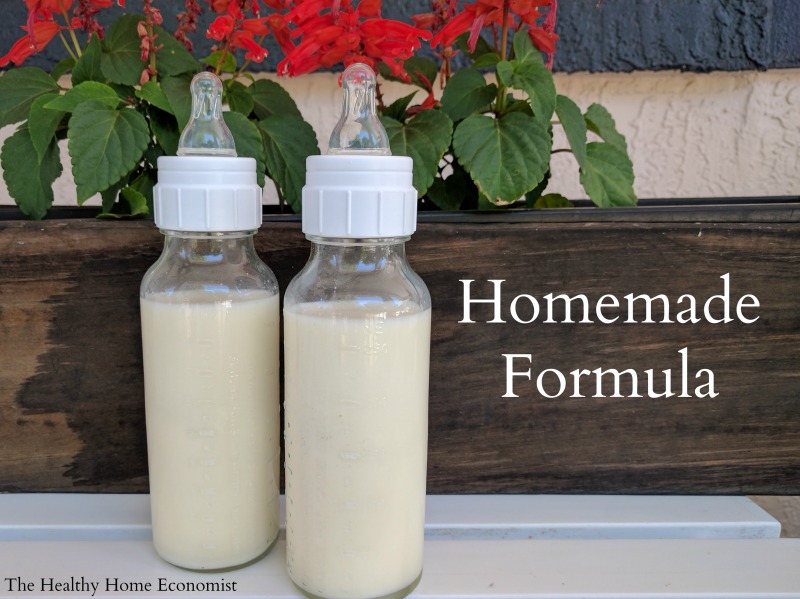
There is no doubt that breastfeeding your baby is the best option for the child’s long-term health and development. Human breastmilk from a well-nourished mother is the perfect food for baby. However, in circumstances where the child is adopted or the Mother finds herself unable to breastfeed, formula feeding becomes necessary. In those cases, homemade baby formula is best.
Using a baby formula recipe that closely matches the nutritional profile of breastmilk is a far better choice than even organic baby formula from the health food store. More on this below.
Note: Donor programs are widely available for human breastmilk. But, the diets of the donor mothers are unknown and most likely nutritionally insufficient. In addition, breastmilk banks pasteurize the donated breastmilk which destroys much of the nutritional benefit. Unless you are fortunate to have a trusted and direct donor milk source in your community, avoid this option!
Dangers of Commercial Formula
Commercial formulas are always a poor choice for a number of reasons. First of all, formula manufacturers line the cans with the chemical BPA. This substance disrupts hormone development and is a probable contributor to early puberty in girls, and ADHD, urogenital abnormalities, and other ills in boys.
The European Food Safety Authority found that canned commercial formula is a significant source of BPA for infants, exposing the child to 13mcg of BPA per kg of body weight per day! BPA-free formula cans are no better. The chemical BPS is typically used instead which is just as dangerous.
Beware that manufacturers pack even organic commercial formula like Earth’s Best in BPA cans. Worse, they use organic brown rice syrup as the primary sweetener which is known to be frequently contaminated with arsenic.
In addition, all commercial milk formulas are processed at extremely high temperatures which violently denature the fragile milk proteins, render them allergenic, and add carcinogens to the final product. Soy infant formula is the worst. Obscenely high processing temperatures not only denature the proteins but large levels of phytic acid in soy block mineral absorption by the infant. Moreover, soy-based plant estrogens disrupt the hormonal development of the baby!
It seems that for the concerned Mother who is unable to breastfeed, learning how to make baby formula at home with safe, pure ingredients is the most prudent way to go!
Why Make Homemade Formula Even if You Are Breastfeeding
In the video below, I show you how to make your own safe, healthy raw milk homemade formula for your baby.
The recipe I follow was originally published in the cookbook Nourishing Traditions in 1996 and developed by Dr. Mary Enig.
Even though I breastfed each of my children for at least 2 years, I made this exact formula for my own children when I was away for the day or the evening as pumping was not an option that worked well for me.
I even used this homemade formula for an entire day once when I had some dental work done and was advised to pump and discard for 24 hours.
As a result, even successfully breastfeeding Moms can use this wonderful homemade formula as a supplement when necessary to their own nutrient-dense breastmilk!
It is advised that even breastfeeding Mothers have the ingredients for this formula on hand for an emergency. If Mom is sick or otherwise unable to nurse, Dad can step in and make this safe alternative until Mom is back on her feet. It takes a few days to a week to gather all the ingredients together to make this formula, which is why I advise having them on hand at all times.
Homemade Most Nutritious
The image below lists the reasons why it is worth it nutritionally to make formula yourself for your precious baby!
You can order all of the required ingredients for the homemade baby formula in one package from this reputable, vetted source.
Moms who have successfully used this formula feeding your children, please post about your experience in the comments section to encourage those who are considering it and need some Mom to Mom encouragement!
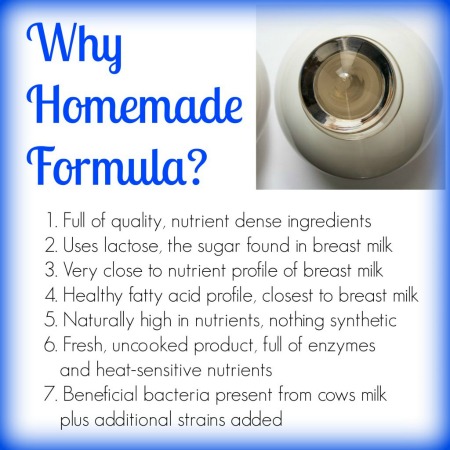
Where to Source Quality Milk
The most widely available grass-fed milk around the world is from cows. This is usually the most budget-friendly and easily sourced milk for this recipe for homemade formula.
If only goat milk is available in your area, this recipe for goat milk baby formula can be used instead. When using milk from ewes, please refer to the linked article for an adjusted recipe; one of the benefits of sheep milk is that it is higher in healthy fats than either goat or cow milk.
Camel milk formula is another option that is a particularly digestible form of dairy and growing in popularity around the world.
Alternatively, you can use low temp (vat) pasteurized, non-homogenized whole milk cultured with a piima or kefir starter. Then substitute the piima milk or kefir for the raw milk portion of the formula recipe. Cold-pressed raw milk also must be cultured before using it as it contains no probiotics.
Do NOT use ultrapasteurized (UHT) milk even if organic as it is too highly processed and extremely allergenic!
It is also best to avoid all types of powdered milk for this recipe. The factory process of making milk powder reduces nutrition considerably and denatures it, which makes it more likely baby will have an allergic reaction.
Dairy Allergy Option
If all types of dairy prove unsuitable for your baby, make this nondairy baby formula recipe instead. It uses a base of homemade bone broth as a substitute for milk. It is important not to utilize a plant-based or otherwise vegan baby formula recipe.
Avoid buying bone broth to make the dairy-free formula. Make it yourself! Manufacturers of commercial bone broth, even if authentic, may water down the end product. This is apparent if it does not gel when chilled in the refrigerator.
Many brands have toxic packaging issues as well. If you must buy it in a pinch, see my shopping guide page for vetted brands that are safe.
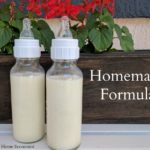
Homemade Baby Formula Recipe (for infants too)
A nourishing baby formula recipe you can make at home with safe, whole ingredients developed and tested by a PhD nutritionist to match breastmilk as closely as possible. Also suitable for infants.
Ingredients
- 2 cups raw cow milk OR organic whole milk yogurt
- 1 7/8 cups filtered water
- 1/4 cup liquid whey
- 4 Tbl lactose
- 1/4 tsp Bifidobacterium infantis powder
- 2-4 Tbl raw or pasteurized cream
- 1/2 tsp cod liver oil unflavored
- 1/4 tsp butter oil unflavored
- 1 tsp sunflower oil preferably organic
- 1 tsp extra virgin olive oil preferably organic
- 2 tsp virgin coconut oil preferably organic
- 2 tsp nutritional yeast
- 2 tsp gelatin
- 1/4 tsp acerola powder
Instructions
-
Fill a 2 cup Pyrex measuring cup with filtered water and remove 2 TBL (this will give you 1 7/8 cup water).
-
Pour about half the water into a pan and turn burner on medium.
-
Add the gelatin and lactose and let dissolve, stirring occasionally.
-
When gelatin and lactose are dissolved, remove pan from heat and add the rest of the water to cool.
-
Stir in the coconut oil and butter oil until melted.
-
Put remaining ingredients in a glass blender.
-
Add the water mixture and blend for about 3 seconds.
-
Place formula in glass baby bottles or a glass jar and refrigerate.
-
Before giving to baby, warm glass bottle in a pan of hot water or a bottle warmer. NEVER microwave baby bottles!
Recipe Video
Recipe Notes
If using raw cow milk from holstein cows, use 4 Tbl of extra cream (otherwise use 2 Tbl extra cream).
If choosing to make this homemade formula with camel milk, be sure to include 4 Tbl extra cream as camel milk is lower in cream than cow milk.
Do not use high oleic sunflower oil. Use only the brand recommended in the ingredients list which is cold pressed, organic, unrefined, and low oleic.
*Do NOT use powdered whey from the store as it is denatured. Avoid whey from making cheese as it will curdle the formula.
*Do not substitute pasteurized or powdered milk as these are heavily processed, denatured and allergenic foods.
*Do NOT use ultrapasteurized (UHT) cream. It is highly allergenic. Raw or pasteurized cream is acceptable.
*Do NOT use fish oil or krill oil instead of high vitamin cod liver oil as they do not contain any Vitamin D and very little to no Vitamin A.
Collagen powder may be substituted for the gelatin in a pinch (more on peptides in baby formula in this article).
If you are wondering where is the iron in homemade baby formula, this article provides an explanation.
If baby experiences constipation using this formula, try adding 1 tsp of molasses to each batch. This should help move things along.
How to Transition to DIY Formula
Once you’ve viewed the video, gathered the ingredients, and made your first batch, how do you feed it to your baby for the first time?
It is important not to switch all at once as this can cause gas, excessive spit-up, or an uncomfortable change in diaper habits such as constipation or overly loose stools.
Start by giving your baby three-quarters of the old formula blended with one-quarter of the homemade. Try this ratio for a day or two and see how your infant responds.
If no digestive upset or major change in diaper habits occurs, increase the amount to a 50-50 blend of old formula to homemade. Observe for another day or two as before.
If no major issues, increase once again to three-quarters homemade formula to one-quarter old formula. If baby does well on this blend for a third time, you are ready to fully transition to the homemade formula.
At any time during the transition, symptoms of intolerance emerge, back up to the previous successful blend ratio and stay there for a day or two before attempting to increase once again.
Homemade Formula FAQ
Weston Price Foundation
Feeding an Adopted Baby
Traveling Tips with Baby Formula Made at Home
Iron in Baby Formula
Collagen Peptides instead of Gelatin for Homemade Formula?


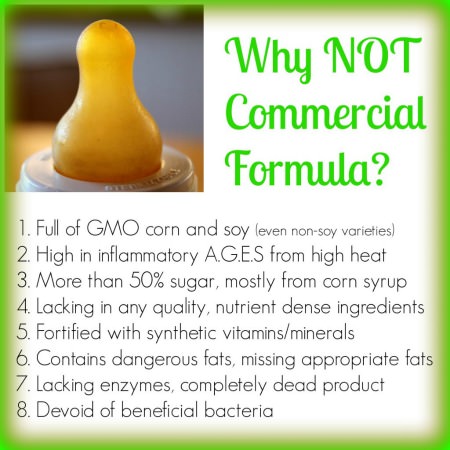
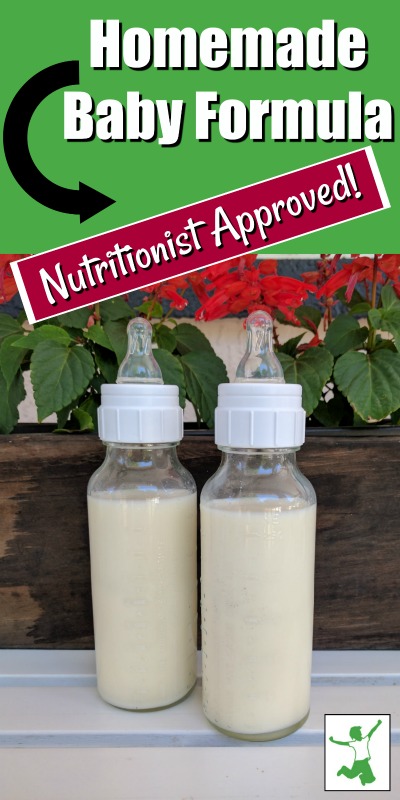






So if my baby is allergic to coconut oil, sunflower seed oil and nutritional yeast flakes…what then? Can I just keep them out on the cows milk formula?
I feel deceived! I am seriously near tears! I am so grateful to you for getting this information out. I did not breastfeed to prevent my children from being prone to leukemia. Long story short the HTLVI & II dormant virus (which I happen to have) is passed through breastmilk. If I knew about the GAPS diet when my children were born I could have breastfed. And, if only I knew about home made formula! And the BPA in canned formula… ‘sob’. I will be throwing out all the gargbage I have been feeding my kids and replacing it with this. Thank you, thank you, thank you!
Sarah and Marilyn,
I meant to post this a week ago so my apologies for the delay. I have boy_girl twins that are 9 months old. I went back to work when the twins were 5 months and stopped breast feeding then. Sarah has been fantastic with advice for baby formula since then. I initially tried to use the raw milk based formula (recipe on Sarah’s website), but like Marilyn found that it constipated the twins – really my son. However, we switched to the raw yogurt based formula and the babies LOVE it. They really took to it and are growing like weeds. I would highly recommend the formula recipe with raw yogurt. Good luck.
Michelle, Can you please email me the list of ingredients/recipe you use for the raw yogurt based formula? The original formula constipates my baby very much. ([email protected]) Thank you in advance!
Nourhan, all you do is substitute raw yogurt for the 2 cups of raw milk. Everything else stays the same.
Thanks Michelle!
Sarah – We’ve been feeding this formula to our sweet Eli for the last three months or so and are praising the Lord for a sound alternative to commercial formula. He is thriving and is such a happy little guy. He was hospitalized in February with RSV but recovered much more quickly than I was told to expect – in fact, our ped was surprised by how well he was just a week later. While I am sad to not be able to nurse this time I am so glad that I know exactly what is going into his little body – and for me, this has been a big comfort to me. Thanks for the great site and really helpful videos. Mary
Just stumbled upon your site. Looks great! FYI – I emailed Earth’s Best when my child was born and they informed me that their formula cans do NOT contain BPA.
Hi Sarah…just wondering, I live in Canada and it’s so hard to find any good milk here. All we have in our dairy sections is homogenized pasterized milk. My son is 2 years old and still breastfed, but we are expecting again soon and I would like to have this formula on hand just in case as you say, but finding the actual milk part is what i’m having problems with. Any suggestions?
I also live in Canada and I just finished gather ingredients . You won’t find unhomoginized milk at the grocery store. You need to find an organic or whole foods market or a dairy if available in your area. I have done my research and harmony organics natures whole milk is the best brand availble. You could also try to find a cow share in your area to get the raw milk but most of them are not accepting new members. I live in Ontario where raw milk is illegal to sell so I use the milk I mentioned and cultur it with piima.
Hi Sara,
Just wondering, is it ok to add some organic blackstrap molasses to the baby formula? If so, how much should I add? I heard that the molasses will help with constipation.
Is this appropriate sort of milk to use with the homemade formula? http://www.jdcountrymilk.com/Home_Page.html Would it need to be converted to kefir to use in the recipe? Right now, we are comfortable with using donor breast milk we have but aren’t sure how long we will be able to do so for our daughter. We live 30 minutes from Whole Foods Market.
HI Heather, the milk is low temp pasteurized which is ok but it seems to be homogenized (there is no creamline on the milk to be seen) which is a no no. You need low temp pasteurized, nonhomogenized milk .. it would be best at that point to make kefir out of it and then make the formula since it is pasteurized, even if low temp.
does making culturing milk make the milk taste too sour for the baby to swallow?
Hi Sara,
I tried the baby formula about two weeks ago for my 7 month old baby. He loves it and is doing wonderfully, except that he is constipated. I tried increasing the whey and the bifidobacterium infantis (i added an extra 1/4 cup of whey and an extra 1/4 teaspoon of the infantis) because i read on one of the posts that increasing these ingredients could help with constipation, but my baby is still constipated. What should I do to stop the constipation?
Marilyn, try making the formula with raw yogurt or kefir instead. I know one Mother who did this and it eliminated the constipation problem.
That sounds great! Thank you! I will definitely try that. As for the raw yogurt, what’s the best way for me to make it? I’ve never made it before. I wish you had a video on how to make it. I do not want to buy yogurt from the store that’s made from pasteurized milk to make raw yogurt. That just doesn’t make sense to me. Should I buy a yogurt culture online that’s made from raw milk or should I make yogurt from a probiotic? If so, which brands of probiotic should I use and also do you know of anyone online selling any raw milk yogurt cultures?
Hi Marilyn, make raw kefir as it is easier to do than raw yogurt I think. Just get a kefir culture and put it in a quart glass jar with your raw milk and leave on the counter for about 24 hours. I have a video on this if you click “video classes” at the top of the screen.
Ok great! Thank you so much! Where can I get the kefir culture? I really want to learn how to make raw yogurt. What’s the best way for me to make it?
Hi Marilyn, Cultures for Health is great for both yogurt and kefir starters .. here’s the link on my resources page:
https://www.thehealthyhomeeconomist.com/resources/#starters
Sara, thanks so much! You are the best!
I did a cost comparison break down on my blog
http://troyerfamilyhome.blogspot.com/2011/03/homemade-baby-formula-cost-comparison.html
if anyone is interested. I tried to be as accurate as possible, using mostly the links from here for the supplies.